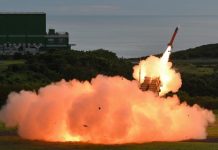While China has offered assistance to India to fight the Covid-19 pandemic, the Indian Army, other the other hand, continues to upgrade its border infrastructure along the contentious Line of Actual Control (LAC) to counter China’s growing militarization in the region.
Indian Army’s Northern Command has put in place various measures and protocols to ensure that the operational capabilities do not take a hit amid the Covid-19 pandemic, according to ThePrint.
The Indian military continues to monitor Chinese activities through physical means besides drones and satellite imagery. While China has offered to help India in fighting the pandemic, the Chinese PLA has maintained a considerable presence in the depth areas in Ladakh despite the disengagement from the Pangong Tso, The EurAsian Times reported.
The 11th Round of India-China Corps Commander Meeting was held earlier this month to discuss the next round of de-escalation but remained largely inconclusive. Reports suggest the pandemic might delay the next round of military-level talks by a few months.
Despite this, the Indian soldiers continue to communicate with their Chinese counterparts through the hotline to ensure peace and stability in the region.
India, China Infrastructure Development
Most of the construction work in the Himalayan region is carried out during the summer period as the region becomes inhospitable and sometimes inaccessible in the winter when temperatures plummet up to -40 degrees celsius with 30-40 feet of snowfall.
Himachal Pradesh: Prime Minister Narendra Modi at Atal Tunnel, Rohtang
It is the longest highway tunnel in the world built at an altitude of 3000 meters. The 9.02 Km long tunnel connects Manali to Lahaul-Spiti valley pic.twitter.com/yh2KmITCSB
— ANI (@ANI) October 3, 2020
India’s rapid infrastructure development has served as a deterrent for PLA, analysts say.
According to Hindustan Times, the infrastructural development has been undertaken by New Delhi through the comprehensive Integrated Border Management Systems including border outposts, border fencing, mobile towers, and the use of technology by the border forces.
Rapid construction of roads, helipads, tunnels, and bridges has also been going on.
The construction of the Atal Tunnel, the world’s longest high-altitude tunnel built above 10,000 feet, was completed last year and has reduced the travel time between Manali and Leh by four to five hours, giving the Indian military better access to border areas.
Taylor Fravel, professor of International Relations at MIT and author of two major books on China’s territorial disputes and its military strategy, “The simplest explanation perhaps is that China is responding to India’s efforts to bolster border-area infrastructure in Ladakh after the completion of the Darbuk-Shyok-DBO (DSDBO) road.
After India’s move into Doklam in 2017, China is perhaps especially sensitive to Indian activity along the disputed border. Around Galwan, in particular, China may be seeking to pre-empt an Indian effort to improve its links to the LAC.”
Other than the ongoing project which includes the construction of 3,323 km roads along the boundary with China, the Ministry of Defense is working on additional 104 roads (around 6,700 km) along the Line of Actual Control (LAC) in Ladakh, Himachal Pradesh, Sikkim, Uttarakhand and Arunachal Pradesh, The Tribune reported.
The ongoing projects, called the India-China Border Roads (ICBRs), have been classified as strategically important. China has been increasingly unhappy with India’s border development work.
During the 7th round military-level talks last year, Chinese foreign ministry spokesman Zhao Lijian claimed that “the stepping up of infrastructure building by India and military deployment along the border with China was the root cause of tensions.
India has also increased patrolling along the LAC to keep a check on Chinese activities, especially the infiltration routes and to assert India’s presence.
New Delhi’s policy towards Beijing has been a mix of economic, diplomatic and military options. Amid the rising military aggression by China, it is imperative to prioritize both the nation’s infrastructural and military build-up in order to counter Beijing.




